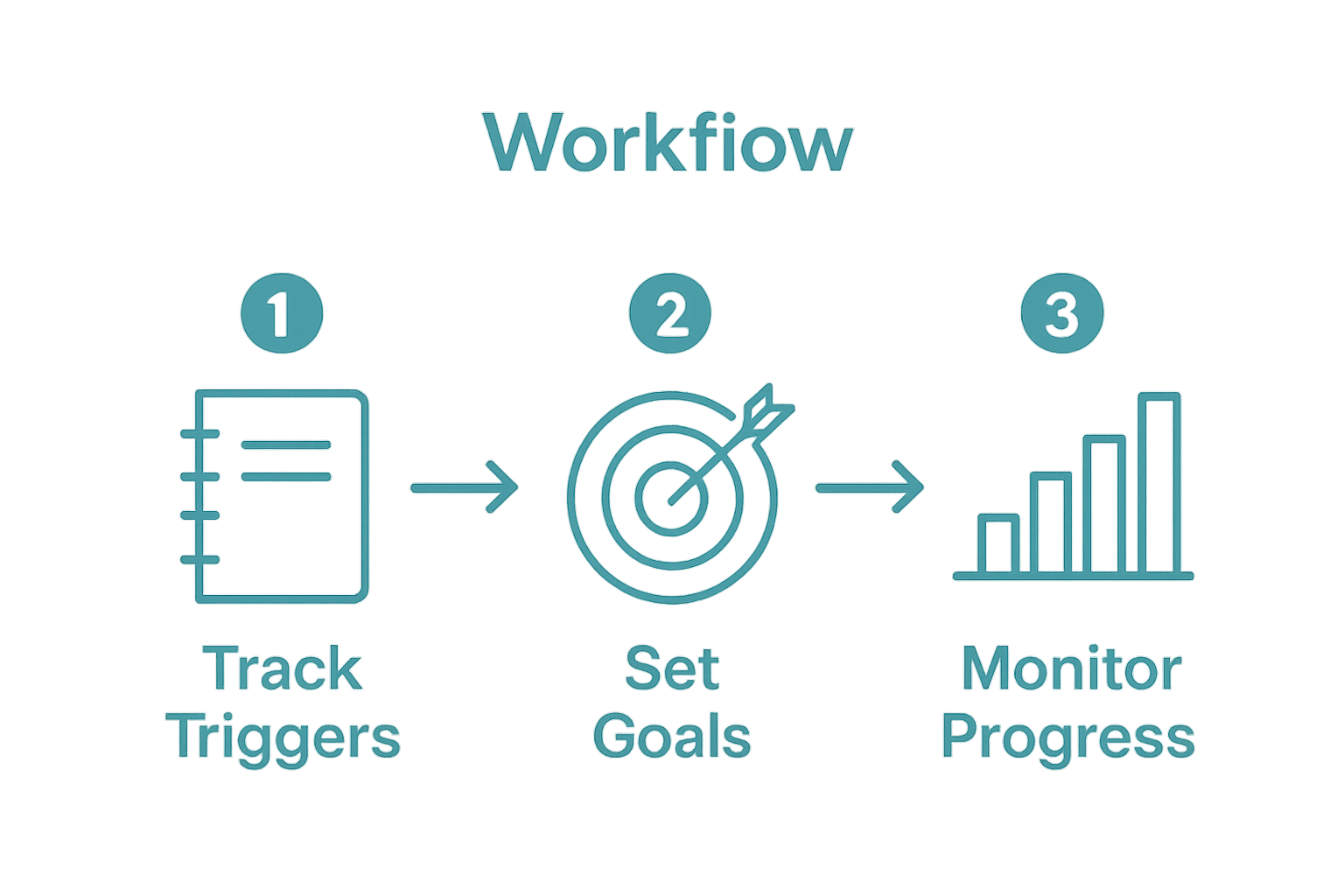

How to Create a Quit Smoking Plan Naturally for Wellness
Quitting smoking sounds impossible when cravings hit out of nowhere and old routines pull you back. But one surprising fact changes everything. People who keep a detailed smoking journal for just one week often uncover 3 to 5 recurring triggers they never noticed before. That means quitting is not about pure willpower but about unlocking the hidden patterns that quietly control your habit.
Table of Contents
- Step 1: Assess Your Smoking Habits And Triggers
- Step 2: Set Clear And Achievable Goals
- Step 3: Develop Strategies To Manage Withdrawal Symptoms
- Step 4: Create A Support System With Friends Or Professionals
- Step 5: Monitor Progress And Adjust Your Plan
Quick Summary
| Key Point | Explanation |
|---|---|
| 1. Track Your Smoking Patterns | Maintain a smoking journal for a week to understand your triggers and habits. |
| 2. Set Specific, Measurable Goals | Establish clear short-term and long-term smoking cessation goals to motivate progress. |
| 3. Manage Withdrawal Symptoms Effectively | Develop coping strategies like exercise and mindfulness to address withdrawal challenges. |
| 4. Build a Support System | Create a network of family, friends, and professionals to provide emotional and practical support. |
| 5. Regularly Monitor Your Progress | Keep a detailed journal to track changes and adjust your quit plan as needed. |
Step 1: Assess Your Smoking Habits and Triggers
Creating a successful quit smoking plan begins with understanding your unique smoking patterns and identifying the precise triggers that fuel your habit. This critical first step provides the foundation for developing a personalized strategy that addresses your specific challenges and psychological dependencies.
To effectively map out your smoking behaviors, start by maintaining a detailed smoking journal for one complete week. This isn’t just about tracking how many cigarettes you consume, but understanding the deeper context of each smoking moment. Record not just the quantity, but the specific circumstances surrounding each cigarette. Note the time of day, your emotional state, who you were with, what you were doing, and what feelings or stressors preceded your decision to smoke.
As you document your smoking patterns, you’ll likely discover recurring triggers that prompt your smoking behavior. These might include stress at work, social situations, morning coffee, after meals, during breaks, or specific emotional states like anxiety, boredom, or frustration. Some individuals find they smoke more when drinking alcohol, while others light up during specific social interactions or when experiencing particular emotional pressures.
Analyzing these patterns allows you to develop targeted strategies for each trigger. For instance, if you realize you consistently smoke during work breaks, you can proactively plan alternative stress-relief techniques like deep breathing, short walks, or read more about natural nicotine craving alternatives. By understanding your unique smoking landscape, you transform a seemingly uncontrollable habit into a manageable challenge with clear intervention points.
Below is a table summarizing common smoking triggers, their contexts, and suggestions for alternative actions based on information already discussed in the article.
| Common Trigger | Typical Context | Suggested Alternative Action |
|---|---|---|
| Stress at work | During work breaks | Deep breathing, short walk |
| Social situations | With friends or coworkers | Hold a drink, use herbal alternatives |
| Morning coffee | Starting the day | Replace cigarette with herbal tea |
| After meals | Post-eating routine | Brush teeth, chew gum |
| Alcohol consumption | While drinking | Switch to non-alcoholic beverages |
| Anxiety, boredom, frustration | Emotional discomfort | Mindfulness, journaling, exercise |
| Specific routines | Regular daily tasks | Plan out new healthier habits |
The verification of a successful assessment involves recognizing and documenting at least 3-5 consistent smoking triggers and understanding their psychological or situational roots. Your smoking journal becomes a roadmap, revealing not just when you smoke, but why you smoke. This self-awareness is your most powerful tool in developing a natural, holistic approach to quitting.

Remember, this step is about honest self-reflection. Don’t judge yourself during this process—simply observe and document. The insights you gain will be instrumental in crafting a quit smoking plan that resonates with your individual needs and sets the stage for sustainable wellness.
Step 2: Set Clear and Achievable Goals
Transforming your smoking cessation journey requires more than good intentions—it demands strategic goal setting that provides structure, motivation, and a clear pathway to success. This step is about creating a realistic roadmap that breaks down the daunting challenge of quitting into manageable, incremental objectives that build your confidence and reinforce your commitment.
Begin by establishing both short-term and long-term goals that are specific, measurable, and meaningful to your personal wellness journey. Instead of a vague commitment like “I want to quit smoking,” craft precise goals such as “I will reduce my daily cigarette consumption by 50% in the next four weeks” or “I will be completely tobacco-free within three months.” These clearly defined targets transform an abstract desire into a concrete plan of action.
Your goals should follow a gradual reduction strategy that allows your body and mind to adapt. This might involve creating a structured timeline where you progressively decrease your cigarette intake. For example, if you currently smoke 20 cigarettes daily, your initial goal could be reducing to 10 cigarettes per day within the first two weeks, then dropping to 5 cigarettes daily in the subsequent two weeks. This approach minimizes withdrawal shock and increases your likelihood of sustainable success.
Psychological preparation is equally crucial. Develop emotional resilience goals that complement your physical smoking reduction. These might include practicing daily stress management techniques, exploring alternative wellness strategies for reducing nicotine cravings, or committing to weekly mindfulness practices that support your overall health transformation.
To verify the successful completion of this goal-setting step, your objectives should meet three critical criteria:
- Specificity: Each goal must be clear and unambiguous
- Measurability: You should be able to track and quantify your progress
- Timebound: Establish realistic deadlines for each goal milestone
Remember that goal setting is not about perfection but progress. Some days will be more challenging than others, and that’s entirely normal. The key is maintaining flexibility while staying committed to your overall wellness vision. Your goals are a supportive framework, not a rigid constraint—they should motivate and inspire you, not create additional stress.
By crafting thoughtful, personalized goals, you’re not just planning to quit smoking; you’re designing a comprehensive approach to reclaiming your health and transforming your relationship with wellness.
Step 3: Develop Strategies to Manage Withdrawal Symptoms
Successfully quitting smoking requires more than willpower—it demands a comprehensive approach to managing the complex physical and psychological challenges of nicotine withdrawal. This critical step focuses on developing a holistic toolkit of strategies that will help you navigate the challenging transition period with resilience and confidence.
Understanding that withdrawal symptoms are temporary and manageable is the first crucial mental shift. Your body will experience significant changes as it adjusts to the absence of nicotine, which can manifest as irritability, anxiety, increased appetite, headaches, and intense cravings. Preparing for these symptoms in advance transforms them from overwhelming obstacles into manageable challenges.
Physical activity emerges as a powerful natural intervention during withdrawal. Regular exercise helps regulate mood, reduce stress, and provide a healthy alternative to smoking. Consider integrating daily movement that matches your fitness level—this could range from gentle walks and yoga to more intense cardiovascular activities. The key is consistent, enjoyable movement that helps redirect your energy and supports your body’s healing process.
Mindfulness and stress management techniques become invaluable tools in your quit smoking arsenal. Deep breathing exercises, meditation, and progressive muscle relaxation can significantly mitigate withdrawal-related anxiety and cravings.
VIDEO:video_content] Develop a daily practice of 10-15 minutes of mindfulness, using techniques that resonate with your personal comfort level. [Learn more about natural strategies for reducing nicotine cravings to complement these techniques and support your wellness journey.
To verify the successful implementation of withdrawal management strategies, assess your progress through these key indicators:
- Ability to recognize and redirect craving triggers
- Consistent use of alternative coping mechanisms
- Reduction in the intensity and frequency of withdrawal symptoms
- Maintenance of a positive, solution-oriented mindset
Hydration, nutrition, and adequate sleep play critical supporting roles in managing withdrawal. Increase water intake, consume nutrient-dense foods that support cellular repair, and establish a consistent sleep routine. These foundational wellness practices provide your body with the resources needed to heal and adapt.
Remember that withdrawal is not a linear process. Some days will feel easier than others, and that’s perfectly normal. Your strategies are not about achieving perfection but about building resilience and creating sustainable wellness habits that extend far beyond quitting smoking.
Step 4: Create a Support System with Friends or Professionals
Quitting smoking is not a solitary journey—it’s a transformative process that thrives on connection, understanding, and collective support. This critical step focuses on building a robust network of allies who will provide emotional encouragement, practical assistance, and accountability throughout your wellness transformation.
Selecting the right support network requires strategic and honest communication. Begin by identifying individuals who genuinely want to see you succeed and understand the complexity of your quit smoking goal. This might include close family members, trusted friends, supportive coworkers, or healthcare professionals who can offer both emotional and professional guidance. Be transparent about your intentions, sharing not just your goal to quit, but the specific ways they can support you effectively.
Professional support can dramatically enhance your quit smoking strategy. Consider consulting healthcare providers who specialize in smoking cessation, such as primary care physicians, addiction counselors, or therapists trained in behavioral change. These professionals can provide personalized strategies, recommend evidence-based interventions, and help you navigate potential challenges. Some may also suggest natural alternatives for managing nicotine cravings that align with your wellness goals.
Group support programs offer another powerful avenue for connection and motivation. Smoking cessation support groups—whether in-person or online—create a community of individuals sharing similar challenges and victories. These groups provide a safe space to discuss struggles, learn coping mechanisms, and celebrate milestones. The collective wisdom and shared experiences can be incredibly empowering, reminding you that you’re not alone in your journey.
To verify the successful creation of your support system, assess these key elements:
- Diverse support sources (personal connections, professionals, group support)
- Clear communication about your goals and needed support
- Established accountability mechanisms
- Emotional and practical resources in place
Remember that building a support system is an ongoing process. Be open to adjusting your network, communicating your evolving needs, and expressing gratitude to those supporting your wellness journey. Some supporters may naturally become more involved, while others might provide periodic encouragement. The key is maintaining open, honest communication and remaining committed to your health transformation.
Your support system is more than a safety net—it’s a powerful catalyst for sustainable change, providing the human connection and professional guidance that can turn your quit smoking goal from a personal challenge into a shared triumph.
Step 5: Monitor Progress and Adjust Your Plan
Successful smoking cessation is not a linear journey but a dynamic process of continuous self-reflection, adaptation, and growth. This critical step focuses on developing a flexible monitoring system that allows you to track your progress, celebrate victories, and strategically adjust your approach when challenges arise.
Establishing a comprehensive tracking mechanism is essential for maintaining motivation and understanding your quit smoking trajectory. Create a detailed progress journal that goes beyond simply recording days without smoking. Document your physical changes, emotional shifts, stress levels, trigger encounters, and the strategies that worked or didn’t work in managing cravings. This holistic approach transforms your quit plan from a rigid framework into a living, responsive wellness strategy.
Technology can be a powerful ally in progress monitoring. Utilize smartphone apps, digital wellness trackers, or even simple spreadsheet tools to log your journey. Many applications offer visual representations of your achievements, such as money saved, health improvements, and days smoke-free. These tangible metrics provide powerful motivation during moments of potential relapse. Explore natural alternatives for managing nicotine cravings to supplement your tracking and provide additional support mechanisms.
Regular self-assessment is crucial. Schedule weekly check-ins with yourself to review your progress, honestly evaluate your challenges, and make necessary adjustments.
Use the following table to check if you have met the recommended criteria for effective goal setting and progress tracking as described throughout the guide.
| Step | Verification Criteria | How to Confirm |
|---|---|---|
| Smoking Journal | Identified at least 3-5 consistent triggers | Patterns and triggers clearly logged in your journal |
| Goal Setting | Goals are specific, measurable, and timebound | Written objectives with deadlines and progress notes |
| Withdrawal Strategies | Use coping mechanisms for cravings and stress | Documented use of exercises or mindfulness daily |
| Support System | Built network with personal and/or professional contacts | List of supporters and accountability contacts |
| Progress Monitoring | Regularly update journal and adjust plan as needed | Weekly self-check-ins and plan adjustments tracked |
To verify the successful implementation of your progress monitoring approach, assess these critical indicators:
- Consistent and honest journaling of quit smoking journey
- Ability to identify and adapt to emerging challenges
- Maintenance of a growth-oriented, non-judgmental mindset
- Proactive approach to seeking additional support when needed
Remember that setbacks are not failures but valuable learning opportunities. If you experience a moment of weakness or temporary relapse, approach it with curiosity and compassion. Analyze the circumstances, understand the triggers, and use this insight to strengthen your quit smoking strategy.
Your monitoring process is a dynamic, evolving tool that reflects your commitment to wellness.
 By maintaining flexibility, practicing self-compassion, and staying committed to your goals, you transform the challenging journey of quitting smoking into a profound pathway of personal transformation and holistic health.
By maintaining flexibility, practicing self-compassion, and staying committed to your goals, you transform the challenging journey of quitting smoking into a profound pathway of personal transformation and holistic health.
Ready to Turn Your Quit Smoking Plan Into Action?
You have just invested time understanding your personal smoking triggers, setting achievable goals, and creating a supportive wellness path. But the true challenge lies in resisting cravings and breaking the pattern without falling back into old habits. The urge to smoke during stress or routine moments can feel overwhelming. Swapping out tobacco for a clean, natural alternative can help you cross that gap with confidence and peace of mind.

Make your next step count with wellness-focused choices. Visit Full Moons Club for a range of premium CBD smokes, hemp cigarettes, and herbal alternatives crafted to support your journey to a nicotine-free life. Every cigarette is made with organic, U.S.-grown hemp and rolled in eco-friendly paper, empowering you to quit naturally while enjoying stress relief and mindfulness benefits. Discover a healthier ritual and start seeing real results from your quit smoking plan today. Explore your wellness options at Full Moons Club and take control of your journey now.
Frequently Asked Questions
What is the first step in creating a quit smoking plan naturally?
Creating a quit smoking plan begins with assessing your smoking habits and triggers by maintaining a smoking journal for a week. This will help you identify patterns and specific circumstances that prompt you to smoke.
How can I set achievable goals for quitting smoking?
To set achievable goals, establish specific, measurable, and time-bound objectives such as reducing your daily cigarette consumption by a certain percentage over a set timeline or planning to be completely tobacco-free by a specific date.
What strategies can I use to manage withdrawal symptoms after quitting smoking?
Strategies to manage withdrawal symptoms include regular physical activity, mindfulness practices like deep breathing and meditation, and maintaining hydration and nutrition to support your body during the adjustment period.
How important is a support system in the journey to quit smoking?
A support system is crucial as it provides emotional encouragement and accountability. Connecting with friends, family, or professionals, or joining support groups can make a significant difference in your quitting journey.

